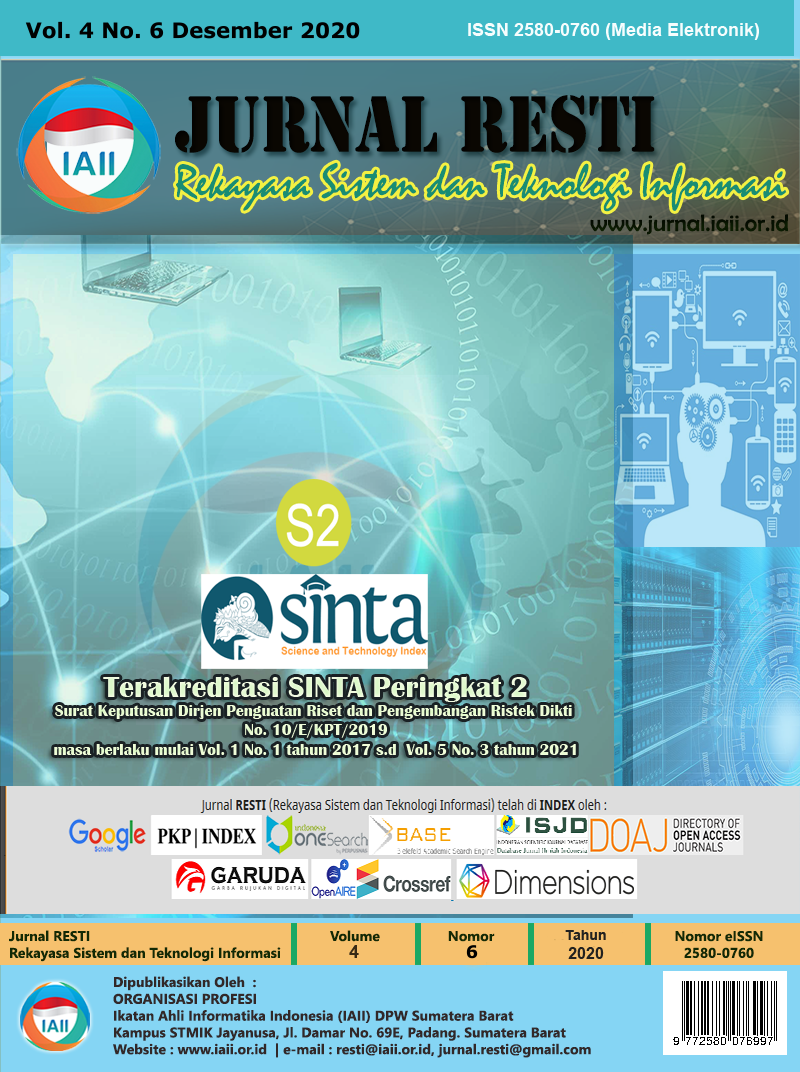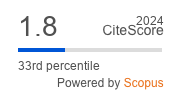Implementasi Algoritma Load Balancing PLBA Komputasi Grid pada Lab Environment Menggunakan PVM3
Abstract
Load balancing is one of the main parts of scheduling Grid resources. One of the load balancing models on Grid resources is the hierarchical model. This model has the advantage that it requires minimal communication costs between one resource and another. The PLBA load balancing algorithm uses a hierarchical model with dynamically obtained threshold values, so that it can adjust conditions at a time, both the state of the resource, the state of the computer network, and the state of the recipient or client. PVM3 is a software system capable of optimizing heterogeneous resources, so that resources can work in parallel. Resources can also complete tasks well, even though they are very large and complex tasks. This research has implemented the PLBA load balancing algorithm, with the aim of optimizing Grid resources. This research has also developed the PLBA load balancing algorithm by changing the arguments for NPEList, so that resources can be grouped more optimally. The PLBA load balancing algorithm has been successfully developed by modifying the arguments for NPEList, so that the running time required to complete the given tasks is shorter, because resources can be grouped more optimally. This has been shown by the shorter average running time when using the modified NPEList argument (0.75 * threshold1 <= ALCi <= 1.25 * threshold1) is shorter, than using the NPEList argument in previous research (ALCi = threshold1). Comparison of the average running time has been obtained as follows : (82513.63740 : 67837.71720); (63869.92450 : 50722.17210); (858,96710 : 207,33680); (321.88000 : 126.89100); (768.54560 : 468.27190); (780.22770 : 279.43730).
Downloads
References
Buyya, R. and Murshed, M., 2002, “Gridsim: A toolkit for the modeling and simulation of distributed resource management and scheduling for grid computing,” Concurrency and Computation: Practice and Experience, vol. 14, no. 13–15, pp. 1175–1220, DOI: 10.1002/cpe.710
Menasce, D.A. and Casalicchio, E., 2004, "A framework for resource allocation in grid computing", In: The IEEE Computer Society's, 12th Annual International Symposium on Modeling, Analysis, and Simulation of Computer and Telecommunications Systems, Volendam, Netherlands, 8-8 Oct. 2004, pp. 259–267, IEEE, DOI: 10.1109/MASCOT.2004.1348280
Prajapati, H.B. and Shah, V.A., 2014, "Scheduling in Grid Computing Environment", In: The Institute of Electrical and Electronics Engineers, Inc., 2014 Fourth International Conference on Advanced Computing & Communication Technologies, Rohtak, India, 8-9 Feb. 2014, pp. 315–324, IEEE, Conference Publishing Services (CPS), DOI: 10.1109/ACCT.2014.32
Goswami, S. and Sarkar, A.D., 2013, “A comparative study of load balancing algorithms in computational grid environment,” In: The Institute of Electrical and Electronics Engineers, Inc., 2013 Fifth International Conference on Computational Intelligence, Modelling and Simulation, Seoul, South Korea, 24-25 Sept. 2013, pp. 99–104, IEEE, Conference Publishing Services (CPS), DOI: 10.1109/CIMSim.2013.24
Qilin, M. and Weikang, S., 2015, "A Load Balancing Method Based on SDN," In: ICMTMA 2015, 2015 Seventh International Conference on Measuring Technology and Mechatronics Automation, Nanchang, China, 13-14 June 2015, pp. 18–21, IEEE, DOI: 10.1109/ICMTMA.2015.13
Jiao, Y. and Wang, W., 2010, "Design and Implementation of Load Balancing of Distributed-system-based Web Server," In: ISECS 2010, 2010 Third International Symposium on Electronic Commerce and Security, Guangzhou, 29-31 July 2010, pp. 337–342, IEEE, DOI: 10.1109/ISECS.2010.81
Ohta, S. and Andou, R., 2009, "WWW server load balancing technique based on passive performance measurement," 2009 6th International Conference on Electrical Engineering/Electronics, Computer, Telecommunications and Information Technology, Pattaya, Chonburi, Thailand, 6-9 May 2009, pp. 884–887, IEEE, DOI: 10.1109/ECTICON.2009.5137187
Patel, D.K., Tripathy, D., and Tripathy, C.R., 2016, “Survey of load balancing techniques for grid,” Journal of Network and Computer Applications, vol. 65, pp. 103–119, DOI: 10.1016/j.jnca.2016.02.012
Guan, H., Li, C.K., Cheung, T.Y., Yu, S. and Tong, W., 1996, "Design and implementation of a parallel software for hybrid neural network computation in PVM environment," Proceedings of Third International Conference on Signal Processing (ICSP'96), Beijing, China, 18-18 Oct. 1996, pp. 1421–1424, IEEE, DOI: 10.1109/ICSIGP.1996.566591
Ponciano, J.P. and Anani, N., 2014, "Load balancing in modern network infrastructures — A simulation model", In: CSNDSP, 2014 9th International Symposium on Communication Systems, Networks & Digital Sign (CSNDSP), Manchester, UK, 23-25 July 2014, pp. 841–846, IEEE, DOI: 10.1109/CSNDSP.2014.6923944
Rathore, N. and Chana, I., 2015, “Variable threshold-based hierarchical load balancing technique in Grid,” Engineering with Computers., vol. 31, no. 3, pp. 597–615 DOI: 10.1007/s00366-014-0364-z
Balasangameshwara, J. and Raju, N., 2012, “Performance-driven load balancing with a primary-backup approach for computational grids with low communication cost and replication cost,” IEEE Transactions on Computers, vol. 62, no. 5, pp. 990–1003, DOI: 10.1109/TC.2012.44
Nanthiya, D. and Keerthika, P., 2013, “Load balancing GridSim architecture with fault tolerance,” In: ICICES, 2013 International Conference on Information Communication and Embedded Systems, Chennai, India, 21-22 Feb. 2013, pp. 425–428, IEEE, DOI: 10.1109/ICICES.2013.6508306
Hao, Y., Liu, G., and Wen, N., 2012, “An enhanced load balancing mechanism based on deadline control on GridSim,” Future Generation Computer Systems, vol. 28, no. 4, pp. 657–665, DOI: 10.1016/j.future.2011.10.010
Setyawan, H.H., Widiarto, W. dan Wiharto, 2020, "Implementasi Algoritma Improvised Prioritized Deadline Scheduling Algorithm (IPDSA) pada Grid Environment", Jurnal RESTI (Rekayasa Sistem dan Teknologi Informasi), Vol. 4, No. 5, Oktober 2020, pp. 957-963, DOI: doi.org/10.29207/resti.v4i5.2457
Sampath, S., Nanjesh, B.R., Sagar, B.B. and Subbaraya, C.K., 2014, "Performance optimization of PVM based parallel applications using optimal number of slaves," In: ICROIT, 2014 International Conference on Reliability Optimization and Information Technology, Faridabad, India, 6-8 Feb. 2014, pp. 388–392, IEEE, DOI: 10.1109/ICROIT.2014.67983
Copyright (c) 2020 Jurnal RESTI (Rekayasa Sistem dan Teknologi Informasi)

This work is licensed under a Creative Commons Attribution 4.0 International License.
Copyright in each article belongs to the author
- The author acknowledges that the RESTI Journal (System Engineering and Information Technology) is the first publisher to publish with a license Creative Commons Attribution 4.0 International License.
- Authors can enter writing separately, arrange the non-exclusive distribution of manuscripts that have been published in this journal into other versions (eg sent to the author's institutional repository, publication in a book, etc.), by acknowledging that the manuscript has been published for the first time in the RESTI (Rekayasa Sistem dan Teknologi Informasi) journal ;








